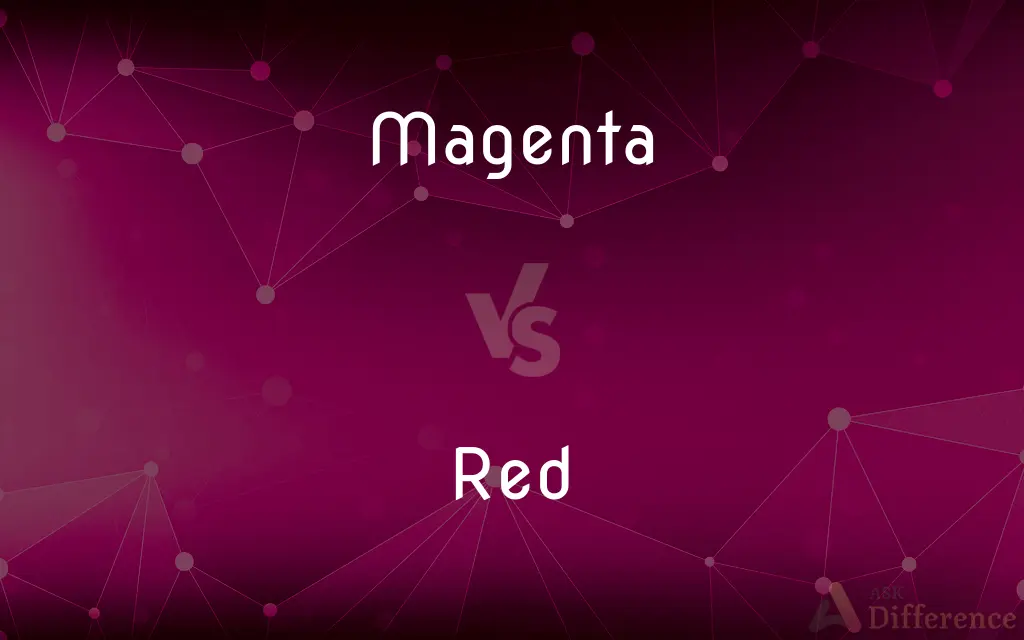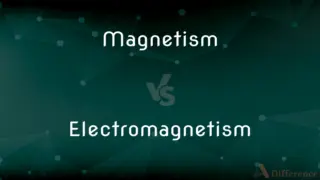Magenta vs. Red — What's the Difference?
Edited by Tayyaba Rehman — By Urooj Arif — Updated on March 11, 2024
Magenta is a deep, purplish-red color representing the combination of red and blue light, while red is a primary color perceived when light with a predominant wavelength is visible.

Difference Between Magenta and Red
Table of Contents
ADVERTISEMENT
Key Differences
Magenta, a color that does not have a singular wavelength of light, is perceived when the brain interprets the combination of red and blue light wavelengths without green. Whereas red is a primary color that appears when the human eye perceives light with wavelengths around 620 to 750 nm, considered one of the most vivid colors in the spectrum.
While magenta is often associated with creativity, harmony, and emotional balance, symbolizing a blend of physical energy and spiritual enlightenment, red is linked with passion, danger, and excitement, often used to grab attention and evoke strong emotions.
In the world of printing and design, magenta serves as one of the primary colors in the CMYK color model, crucial for creating a wide range of colors by mixing with cyan and yellow. On the other hand, red is a fundamental color in both the RGB (Red, Green, Blue) model used for digital displays and the traditional RYB (Red, Yellow, Blue) color model used in art and design education.
Magenta's unique position in color theory highlights the limitations and capabilities of human vision, illustrating how our brains interpret color combinations. Red, however, demonstrates the power of single-wavelength colors and their impact on our psychological and emotional state.
Magenta and red, while both can signify energy and passion, are used differently in art and design to convey specific moods or messages. Magenta can add depth and complexity, suggesting a fusion of ideas, while red often serves as a bold statement color, commanding attention and conveying urgency or importance.
ADVERTISEMENT
Comparison Chart
Light Source
Combination of red and blue light wavelengths.
Light with a predominant wavelength around 620-750 nm.
Symbolism
Creativity, harmony, emotional balance.
Passion, danger, excitement.
Color Model
Primary color in CMYK.
Primary color in RGB and RYB.
Psychological Impact
Encourages balance and innovation.
Evokes strong emotions like love and anger.
Use in Design
Used to create depth and complexity.
Used to command attention and convey urgency.
Compare with Definitions
Magenta
Represents creativity and emotional balance.
Magenta accents in a room can stimulate creativity and emotional well-being.
Red
A primary color that is one of the first colors perceived by humans.
Red lights are often used in traffic signals to indicate stop due to its high visibility.
Magenta
Can appear more vibrant when combined with complementary colors.
A magenta dress can stand out more when paired with green accessories.
Red
Fundamental in both the RGB model for digital displays and the RYB model for art.
Red pixels are crucial for creating the wide range of colors seen on a computer screen.
Magenta
A secondary color created by mixing red and blue light.
Magenta ink is used in printers to produce a wide range of colors.
Red
Directly linked to physical reactions, increasing heart rate and alertness.
Red environments can stimulate energy and alertness in people.
Magenta
Perceived through the combination of red and blue light, lacking a specific wavelength.
Magenta is seen when the brain interprets light without green wavelengths.
Red
Symbolizes passion, danger, and strength.
Red roses are a traditional symbol of love and passion.
Magenta
Primary color in the CMYK color model.
Mixing magenta with cyan and yellow inks produces various colors in print.
Red
Visible when light with a predominant wavelength around 620-750 nm is present.
The red hue of a sunset is due to the longer red wavelengths traveling through the atmosphere.
Magenta
Magenta () is a color that is variously defined as purplish-red, reddish-purple or mauvish-crimson. On color wheels of the RGB (additive) and CMY (subtractive) color models, it is located exactly midway between red and blue.
Red
Red is the color at the long wavelength end of the visible spectrum of light, next to orange and opposite violet. It has a dominant wavelength of approximately 625–740 nanometres.
Magenta
A light mauvish-crimson which is one of the primary subtractive colours, complementary to green
A short magenta dress
Bright pink double flowers each lined in dark magenta
Red
The hue of the long-wavelength end of the visible spectrum, evoked in the human observer by radiant energy with wavelengths of approximately 630 to 750 nanometers; any of a group of colors that may vary in lightness and saturation and whose hue resembles that of blood; one of the additive or light primaries; one of the psychological primary hues.
Magenta
See fuchsin.
Red
A pigment or dye having a red hue.
Magenta
A purplish red, one of the subtractive primary colors.
Red
Something that has a red hue.
Magenta
A vibrant light purple, purplish-red, reddish-purple, or pinkish purple colour obtained by mixing red and blue light (thus a secondary colour), but primary in the CMYK colour system used in printing.
Red
Often Red A Communist.
Magenta
Having the colour of fuchsia, fuchsine, light purple.
Red
A revolutionary activist.
Magenta
An aniline dye obtained as an amorphous substance having a green bronze surface color, which dissolves to a shade of red; also, the color; - so called from Magenta, in Italy, in allusion to the battle fought there about the time the dye was discovered. Called also fuchsin, fuchsine, roseïne, etc.
Red
The condition of being in debt or operating at a loss
The firm has been in the red all year.
Magenta
The purplish-red color of magenta.
Red
Having a color resembling that of blood.
Magenta
A dark purple-red; the dye was discovered in 1859, the year of the battle of Magenta
Red
Reddish in color or having parts that are reddish in color
A red dog.
A red oak.
Magenta
A battle in 1859 in which the French and Sardinian forces under Napoleon III defeated the Austrians under Francis Joseph I
Red
Having a reddish or coppery skin color.
Magenta
Deep purplish red
Red
Often Red Often Offensive Of or being a Native American.
Red
Having a ruddy or flushed complexion
Red with embarrassment.
Red
Relating to or being a red state.
Red
Often Red Communist.
Red
Having red#Noun as its color.
The girl wore a red skirt.
Red
(of hair) Having an orange-brown or orange-blond colour; ginger.
Her hair had red highlights.
Red
(of the skin) With a red hue due to embarrassment or sunburn.
Red
Of the hearts or diamonds suits. Compare of the spades or clubs suits
I got two red queens, and he got one of the black queens.
Red
Supportive of, related to, or dominated by a political party or movement represented by the color red:
Red
Left-wing parties and movements, chiefly socialist or communist, including the U.K. Labour party and the Social Democratic Party of Germany.
The red-black grand coalition in Germany
Red
(US politics) The U.S. Republican Party.
A red state
A red Congress
Red
Amerind; relating to Amerindians or First Nations
Red
(astronomy) Of the lower-frequency region of the (typically visible) part of the electromagnetic spectrum which is relevant in the specific observation.
Red
(particle physics) Having a color charge of red.
Red
Any of a range of colours having the longest wavelengths, 670 nm, of the visible spectrum; a primary additive colour for transmitted light: the colour obtained by subtracting green and blue from white light using magenta and yellow filters; the colour of blood, ripe strawberries, etc.
Red can be seen as hot or angry.
Red
(countable) A revolutionary socialist or (most commonly) a Communist; usually capitalized a Bolshevik, a supporter of the Bolsheviks in the Russian Civil War.
Red
One of the 15 red balls used in snooker, distinguished from the colours.
Red
Red wine.
Red
(countable) Any of several varieties of ale which are brewed with red or kilned malt, giving the beer a red colour.
Red
A red kangaroo.
Red
A redshank.
Red
An American Indian.
Red
(slang) The drug secobarbital; a capsule of this drug.
Red
(informal) A red light a traffic signal
Red
(particle physics) One of the three color charges for quarks.
Red
Usually in the phrase "bowl of red".
Red
(informal) The redfish or red drum, Sciaenops ocellatus, a fish with reddish fins and scales.
Red
Tomato ketchup.
Red
(archaic) rede
Red
To put on order; to make tidy; also, to free from entanglement or embarrassement; - generally with up; as, to red up a house.
Red
Of the color of blood, or of a tint resembling that color; of the hue of that part of the rainbow, or of the solar spectrum, which is furthest from the violet part.
Your color, I warrant you, is as red as any rose.
Red
The color of blood, or of that part of the spectrum farthest from violet, or a tint resembling these.
Red
A red pigment.
Red
The menses.
Red
The quality or state of the chromatic color resembling the hue of blood
Red
A tributary of the Mississippi River that flows eastward from Texas along the southern boundary of Oklahoma and through Louisiana
Red
Emotionally charged terms used to refer to extreme radicals or revolutionaries
Red
The amount by which the cost of a business exceeds its revenue;
The company operated at a loss last year
The company operated in the red last year
Red
Having any of numerous bright or strong colors reminiscent of the color of blood or cherries or tomatoes or rubies
Red
Characterized by violence or bloodshed;
Writes of crimson deeds and barbaric days
Fann'd by Conquest's crimson wing
Convulsed with red rage
Red
(especially of the face) reddened or suffused with or as if with blood from emotion or exertion;
Crimson with fury
Turned red from exertion
With puffy reddened eyes
Red-faced and violent
Flushed (or crimson) with embarrassment
Red
Red with or characterized by blood;
Waving our red weapons o'er our heads
The Red Badge of Courage
The red rules of tooth and claw
Common Curiosities
What is magenta?
A color perceived when the brain interprets a mix of red and blue light, without green.
What symbolism is associated with magenta and red?
Magenta is linked with creativity and balance, while red symbolizes passion and danger.
What is red?
A primary color visible when light with wavelengths around 620-750 nm is detected by the eye.
How are magenta and red used in color models?
Magenta is a primary color in CMYK, while red is primary in RGB and RYB models.
How do magenta and red differ in light perception?
Magenta results from a mix of light, while red is a direct perception of single-wavelength light.
Why is red considered a bold color in design?
Because it commands attention and conveys urgency or importance.
What emotions do magenta and red evoke?
Magenta encourages balance and innovation, while red evokes strong emotions like love and anger.
What role does magenta play in printing?
It's crucial for creating a wide range of colors in the CMYK color model by mixing with cyan and yellow.
Can the use of magenta and red influence mood?
Yes, both can influence mood and reactions—magenta promoting creativity and red stimulating energy and alertness.
What is the significance of red in natural and artificial light?
In natural light, red wavelengths are longer and scatter less, making sunsets red. In artificial light, red LEDs are efficient for signaling and display due to their vividness and low energy consumption.
Can magenta exist as a wavelength of light?
No, magenta is perceived through the combination of red and blue wavelengths, not a single wavelength.
Is magenta more complex than red?
Yes, in terms of perception, as it involves the brain's interpretation of a mix of light.
How do artists use red and magenta differently?
Red is often used for bold statements and to evoke emotions, while magenta can add depth and suggest a fusion of ideas.
How does the perception of magenta demonstrate human vision capabilities?
It shows how our brains can interpret color combinations that do not correspond to a single wavelength of light.
Why is red often used in warning signs?
Its high visibility and association with danger make it effective for grabbing attention and conveying caution.
Share Your Discovery

Previous Comparison
Magnetism vs. Electromagnetism
Next Comparison
Cooperation vs. TeamworkAuthor Spotlight
Written by
Urooj ArifUrooj is a skilled content writer at Ask Difference, known for her exceptional ability to simplify complex topics into engaging and informative content. With a passion for research and a flair for clear, concise writing, she consistently delivers articles that resonate with our diverse audience.
Edited by
Tayyaba RehmanTayyaba Rehman is a distinguished writer, currently serving as a primary contributor to askdifference.com. As a researcher in semantics and etymology, Tayyaba's passion for the complexity of languages and their distinctions has found a perfect home on the platform. Tayyaba delves into the intricacies of language, distinguishing between commonly confused words and phrases, thereby providing clarity for readers worldwide.













































